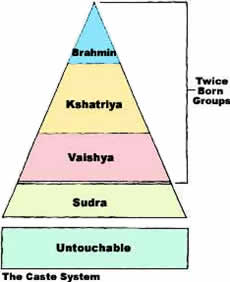 |
| Caste system |
When they divided the Man,Early Aryan society already had class divisions. In India the class stratification became more rigid due to color consciousness—differences in skin color between the Indo-European Aryans and the indigenous peoples—thus the use of the word varna, which originally meant “covering,” associated with the color of the skin covering people’s bodies to differentiate the status of different categories of people.
Into how many parts did they divide him?
What was his mouth, what were his arms,
What were his thighs and feet called?
The brahman was his mouth,
Of his arms was made the warrior,
His thighs became the vaisya,
Of his feet the sudra was born.
The four varna, or broad classifications of peoples of India, were as follows:
- Brahman: priests, teachers, and intellectuals who presided at religious ceremonies, studied, and transmitted religious knowledge.
- Kshatriya: warriors, princes, and political leaders, the people who spearheaded the invasion and settlement of northern India and ruled the land.
- Vaisya: landowners, artisans, and all free people of Aryan society.
- Sudra: dasas, or indigenous people, who were dark skinned and became serfs and servants.
The idea of varna became deeply embedded in Aryan, and later Hindu, society. When Aryan religious concepts later spread to Dravidian southern India, sharp distinctions were also enforced there between the three higher (or Aryan) castes and sudras.
The three high, or Aryan, castes were called “twice born,” because of a sacred thread ceremony or religious birth as they entered manhood, which gave them access to Vedic lore and rituals. Sudras were not eligible, which justified their exclusion from certain religious rites, and their low status.
The Rig-Veda did not mention “untouchables” as a group of people. However, early Aryans were deeply concerned with ritual pollution, which was likely the origin of the Untouchables.
A subclass of Untouchables emerged, who performed “unclean” tasks, such as handling the carcasses of dead animals, tanning, and sweeping dirt and ashes from cremation grounds.
After the late Vedic age Indians defined caste much more narrowly. Besides belonging to a caste, each person belonged to a jati, which was defined as belonging to endogamous groups related by birth (marriage is only legitimate to members within the group), commensality (food can only be received between members of the same or a higher group), and craft exclusiveness (craft or profession can only be inherited; no one can take up another profession). Thus in operation the caste or class system was a combination of varna and jati systems.
Caste had its origins in the class and occupational groups in early Aryan society. It acquired a deep color consciousness as it broadened to include the people of the Indus civilization and other indigenous people the Aryans encountered as they expanded throughout northern India. It continued to develop over the succeeding centuries as a result of association between many racial groups into a single social system.
